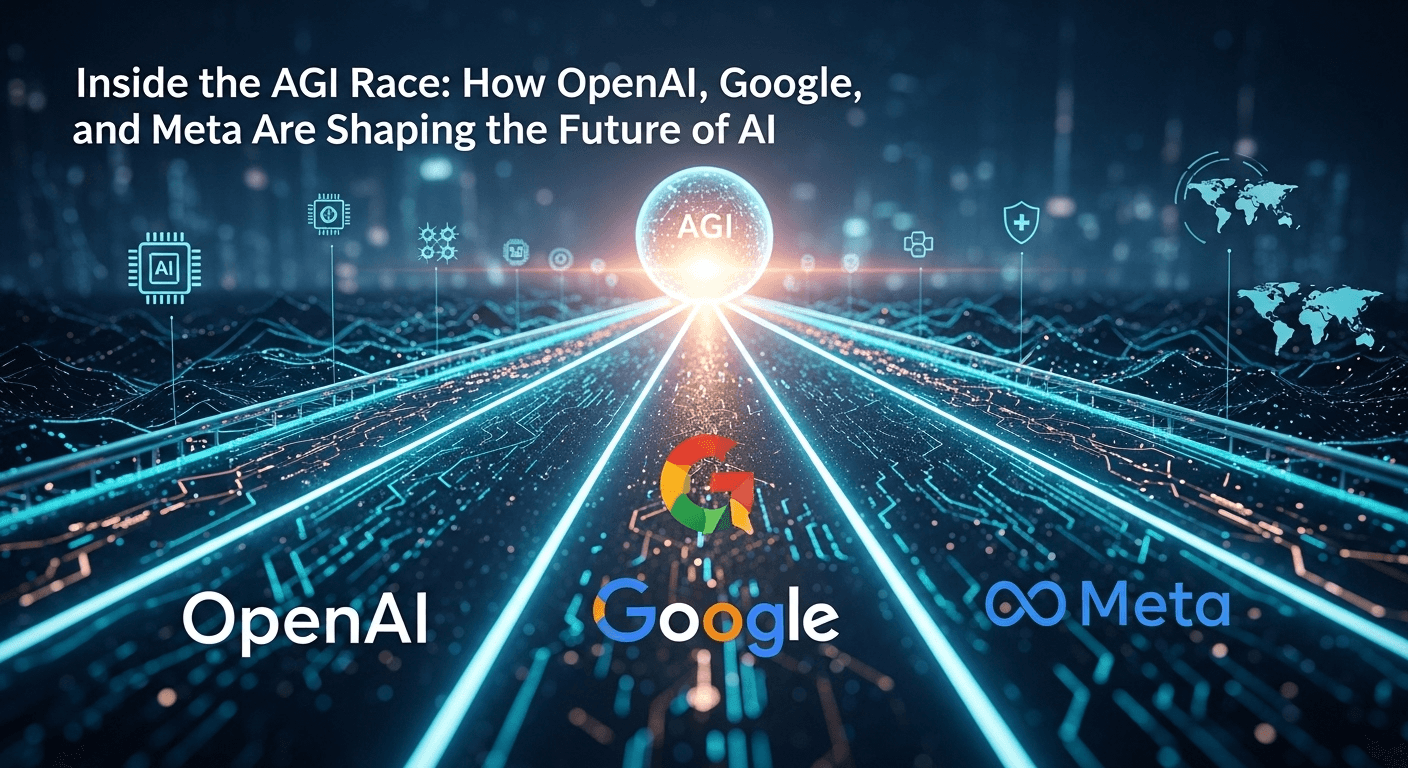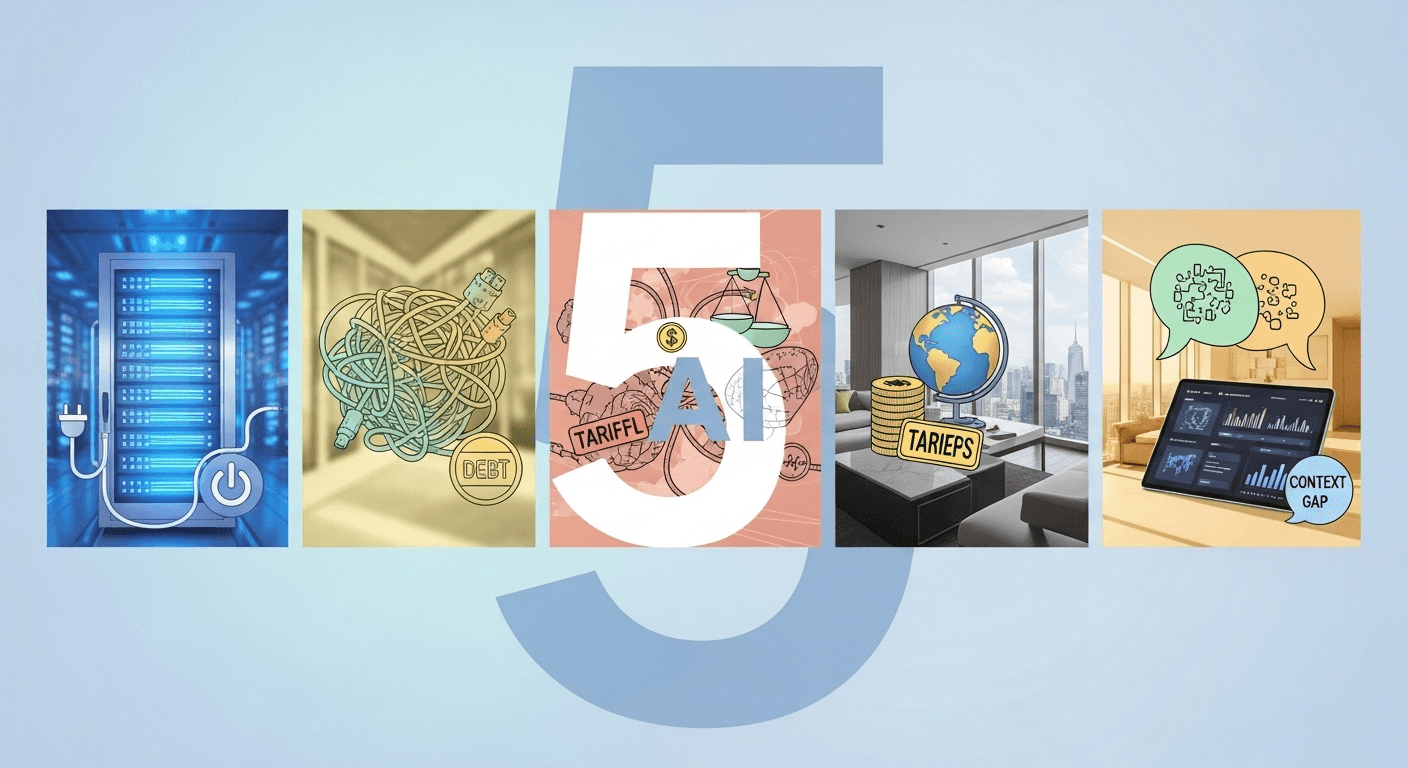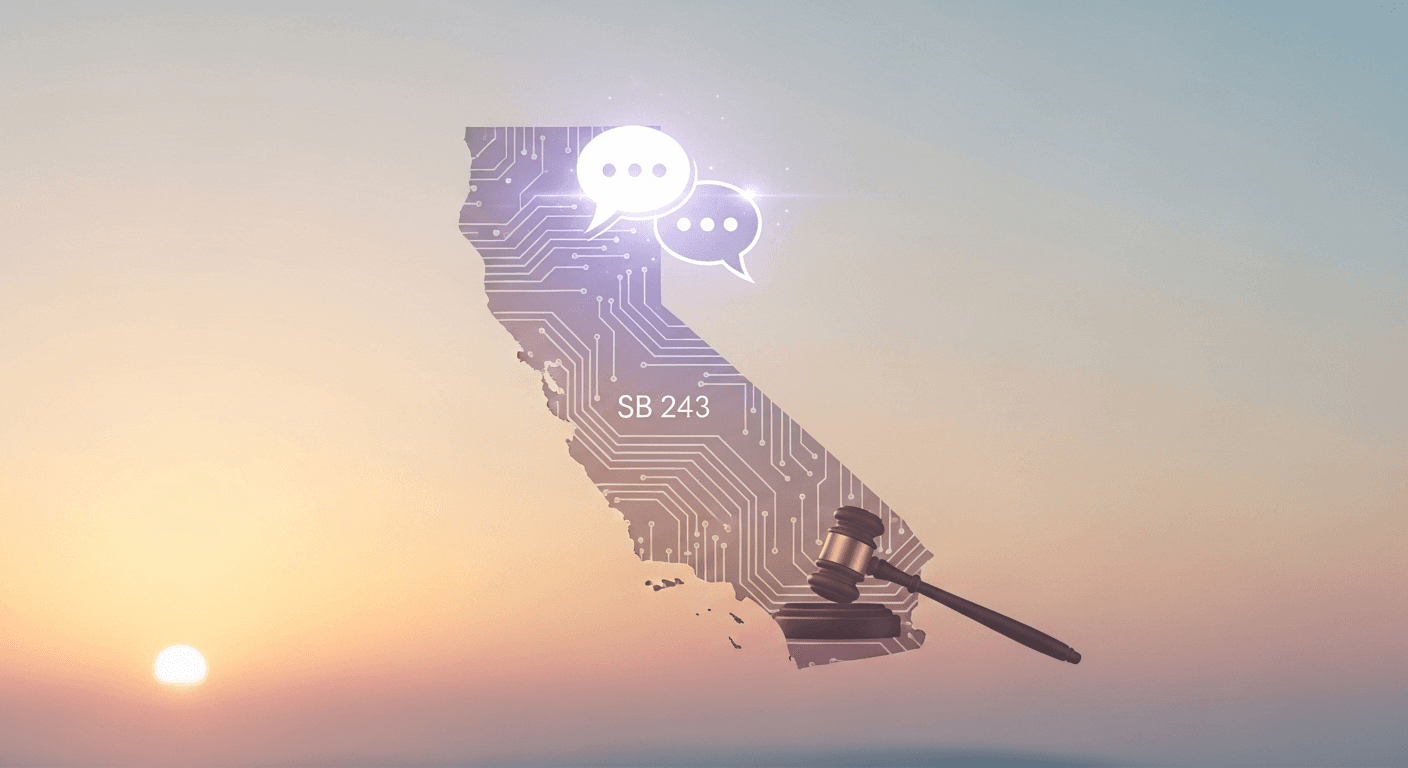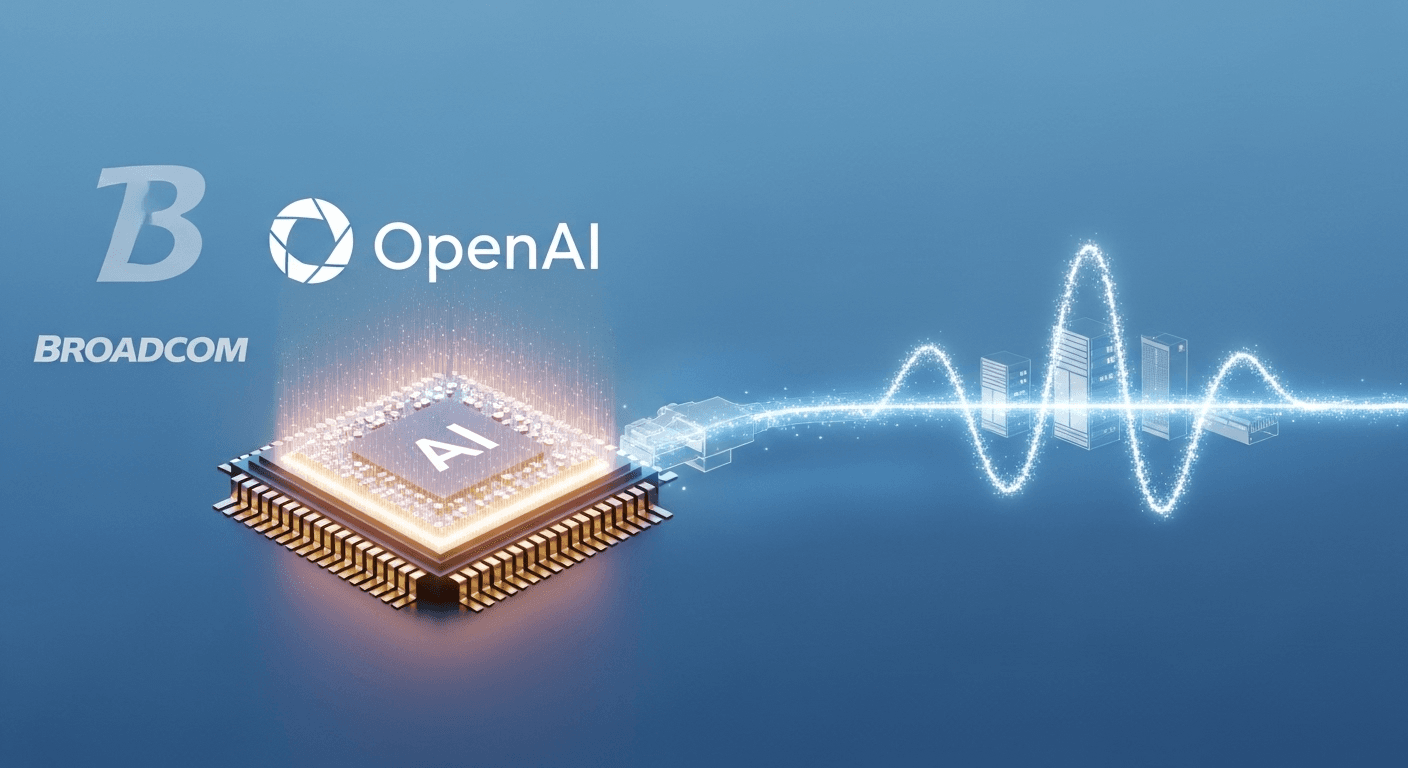Inside the AGI Race: How OpenAI, Google, and Meta Are Shaping the Future of AI

Inside the AGI Race: How OpenAI, Google, and Meta Are Shaping the Future of AI
The world’s leading tech giants are in a fierce competition to develop artificial general intelligence, or AGI. Depending on whom you ask, AGI has the potential to revolutionize fields like medicine, education, and productivity—or it could exacerbate dangers like misinformation and economic instability. OpenAI, Google, and Meta are racing ahead, blending science, engineering, and governance in a rapidly evolving landscape.
What is AGI, and Why Does It Matter?
AGI lacks a universally accepted definition, but generally, it refers to AI systems capable of understanding, learning, and executing a wide array of tasks at or beyond human levels across various fields. OpenAI’s mission emphasizes that AGI should benefit all of humanity, prioritizing safety and accessibility (OpenAI Charter). Google DeepMind focuses on leveraging intelligence to push scientific boundaries and improve human welfare (DeepMind).
Current models are already competing with experts in writing, coding, and analysis, showing impressive advancements in multimodal reasoning and tool utilization. However, developing AGI goes beyond achieving high scores on tests; it involves ensuring robustness, reliability, alignment with human values, and safe deployment worldwide.
OpenAI: Rapid Product Development with a Focus on Safety
Advancements from GPT-4 to GPT-4o: Real-Time Multimodal AI
OpenAI’s approach combines bold research with swift product rollouts. Transitioning from ChatGPT and GPT-4, the newer GPT-4o model is specifically designed for real-time processing of voice, images, and text, designed to minimize latency and costs for developers (OpenAI). This development reflects a belief that future AI applications will be conversational, interactive, and omnipresent.
A Strong Infrastructure for Training and Deployment
OpenAI benefits from a long-standing relationship with Microsoft, accessing substantial computational resources through Azure (Microsoft). Announced in 2024, a partnership with Oracle Cloud Infrastructure will also enhance its model inference capabilities (Oracle). Furthermore, Apple has revealed plans to integrate ChatGPT into Siri and its system-wide writing tools, offering privacy protections and requiring user consent (Apple).
Challenges in Governance and Safety
OpenAI has encountered challenges regarding governance and safety. A leadership shake-up in late 2023 revealed internal conflicts over strategy and oversight (New York Times). Key safety personnel left the organization in spring 2024, leading to a reorganization of long-term risk initiatives and sparking public discussions on prioritizing safety (The Verge). OpenAI even paused one of its models due to concerns of unauthorized resemblance to a celebrity, highlighting growing issues of intellectual property and ethics (NPR).
Despite these setbacks, OpenAI continues to lead in multimodal models, developer tools, and consumer AI experiences. Their commitment to scaling capabilities while addressing safety and governance challenges is evident, especially with the potential exploration of custom silicon for AI (Reuters).
Google: Gemini’s Comprehensive Approach and Scalable Infrastructure
Gemini Models and a Focus on Multimodal AI
Google has consolidated its AI initiatives under the Gemini branding, representing a family of multimodal models ranging from on-device capabilities to expansive, frontier-scale operations (Google). The introduction of Gemini 1.5 has enhanced capabilities for long-context reasoning and improved tool functionality, enabling complex tasks such as processing extensive documents and multimedia content (Google). This approach underscores Google’s strategy to integrate AI across its products like Search, Workspace, and Android (Google).
Navigating Safety Challenges
In early 2024, Google paused its Gemini image generation feature following reports of inaccurate historical representations, leading to an apology and a reevaluation of features (CNBC). This incident highlighted an essential lesson: scaling powerful generative systems also escalates the requirements for rigorous assessments and culturally sensitive defaults.
Leveraging Custom Chips for AI Advancements
Google’s AI innovations are driven by its custom Tensor Processing Units (TPUs), which enhance performance and energy efficiency for both training and inference tasks (Google Cloud). In combination with NVIDIA accelerators, these TPUs allow Google to efficiently train advanced models and provide developers with a robust MLOps ecosystem through Vertex AI and Google Cloud.
Meta: Commitment to Open Weights and Broad Distribution
Llama 3 and an Open-Weight Philosophy
Meta is a vocal proponent of open-weight frontier models. The recent release of Llama 3 demonstrates strong capabilities in coding and reasoning tasks, with a permissive licensing approach intended to foster innovation among startups, researchers, and businesses (Meta AI). CEO Mark Zuckerberg reveals that Meta’s vision is to pursue a path toward more general intelligence, with a focus on open-sourcing much of its framework to enhance safety through increased scrutiny and innovation (The Verge).
Expansive Integration through Major Social Platforms
Meta AI is being woven into Facebook, Instagram, WhatsApp, and even hardware like the Ray-Ban Meta smart glasses, which now facilitate real-time multimodal queries (Meta). This broad distribution strategy positions Meta to be among the most utilized AI products globally, particularly in regions where WhatsApp is a primary communication tool.
Investing in Next-Level Compute Infrastructure
Meta is allocating billions of dollars to enhance its AI hardware capabilities. Zuckerberg has announced plans for an infrastructure equivalent to around 350,000 NVIDIA H100 GPUs by the end of 2024, scaling to approximately 600,000 H100 equivalents when considering other chips, thus aiming to train and support upcoming model generations (Reuters). This monumental investment highlights a broader industry trend: computational power is the new essential resource in the AGI race.
Fostering Collaboration through Open Innovation
In late 2023, Meta collaborated with IBM to establish the AI Alliance, promoting open science, tooling, and weight models within a wide-ranging coalition of academic and industry participants (IBM). This open strategy has its advocates and critics: supporters believe that transparency leads to improved safety and decreases entry barriers, while critics argue that powerful open models could be misused more easily. Both viewpoints are valid, and the details of governance are crucial.
Beyond the Big Three: Notable Contenders in the AGI Landscape
While OpenAI, Google, and Meta garner much of the attention, the AGI ecosystem includes other key players:
- Anthropic focuses on safety and reliability with its Constitutional AI framework and Claude 3 model family, designed for strong reasoning and enterprise applications (Anthropic) (Claude 3).
- xAI, founded by Elon Musk, is developing high-level models like Grok, emphasizing real-time knowledge, with ongoing expansion of its training infrastructure and model availability (xAI).
- Microsoft, Amazon, and other players are venturing into building AI-optimized silicon and services to facilitate a multi-modal future, exemplified by Azure’s Maia and Cobalt chips (Microsoft), AWS Trainium2 aimed at cost-effective large-scale training (AWS), and NVIDIA’s Blackwell platform promising significant upgrades in training and performance (NVIDIA).
Navigating Key Challenges: Data, Compute, and Evaluation
Compute: The Underlying Arms Race
Training cutting-edge models requires vast computational resources and energy. Access to advanced hardware, reliable supply chains, and optimized software systems plays a crucial role in determining which entities can train the next wave of models. Consequently, hyperscalers are securing multi-year chip agreements and creating custom silicon to enhance the capabilities of their data centers for AI workloads.
Data: The Focus on Quality and Governance
The focus is shifting from merely accumulating data to prioritizing high-quality, diverse, and responsibly sourced data. As the era of indiscriminate web scraping collides with intellectual property issues and consent considerations, expect an increase in negotiated data licenses and synthetic data strategies, along with improved filtering and attribution tools.
Evaluation: From Benchmarks to Real-World Applicability
Standard public benchmarks can often be manipulated or overwhelmed. As a result, labs are developing both internal and third-party evaluations to address factors like safety, robustness, tool utilization, and long-term reasoning capacity. The industry is also employing scaling laws, such as DeepMind’s research into compute-data tradeoffs, to design more efficient training processes (Chinchilla scaling laws).
Safety, Alignment, and Governance: Finding the Balance Between Speed and Caution
As capabilities expand, potential risks emerge: hallucinations, exploitation for fraudulent activities or biothreats, privacy breaches, and labor impacts. Policymakers are working to keep pace with these developments:
- The EU has passed the AI Act, establishing comprehensive regulations for AI that outline risk-based obligations and transparency demands (European Parliament).
- In the U.S., a 2023 Executive Order instructs agencies to develop frameworks for safety, security, and reporting related to frontier models (White House).
- National AI Safety Institutes have been launched in both the UK and U.S. for evaluating frontier models and sharing research cooperatively (NIST) (UK Government).
- In 2023, companies committed to voluntary safety standards, which were reinforced in 2024 through global summits emphasizing risk testing, transparency, and labeling for AI-generated content (White House).
Within labs, safety discussions often revolve around trade-offs: open versus closed models, rapid release against thorough testing, and whether merely scaling systems will lead to more reliable reasoning. Anticipate more third-party audits, red-team initiatives, and user default controls, along with policy stipulations for high-risk applications.
Transforming Search and Assistants: The Evolution of AI Interfaces
One of the most significant arenas of competition is the interface layer:
- Google is implementing AI Overviews in Search to address complex queries and guide users through information journeys within its ecosystem (Google).
- OpenAI is progressing toward a voice-first, real-time assistant capable of seeing and speaking, integrating with iOS and macOS for enhanced on-device functionality (Apple).
- Meta is deeply embedding its AI capabilities into daily messaging and social applications, as well as hands-free interactions through smart glasses (Meta).
Ultimately, victory will not go to the company that simply creates the smartest model, but rather to the one that produces the most beneficial, trustworthy assistant in environments where people live and work.
Potential Effects on Work and the Economy
The AGI race is not a zero-sum game; it will produce both winners and fallbacks across different sectors. Anticipate the following trends:
- Productivity enhancers: AI-powered tools will increasingly automate routine tasks in areas like coding, support, legal drafting, and analysis, reshaping workforce skills and workflows.
- Emerging platforms: Agents capable of browsing, coding, querying databases, and performing actions will create new opportunities centered on identity, permissions, and accountability.
- A data strategy advantage: Organizations that can ethically collect, categorize, and manage proprietary data will maintain a strong competitive edge.
- Built-in compliance: Regulated industries will necessitate robust evaluations, tracking of data provenance, and user-controlled processes integrated into AI technology.
While the potential benefits are significant, effective guardrails are crucial. Systematic evaluations, privacy rights, intellectual property protections, and accountability measures will be pivotal in establishing public trust in the technology.
What to Keep an Eye On
- Roadmaps for frontier models: Anticipate larger, more efficient multimodal models with enhanced long-term reasoning capabilities across laboratories.
- Hardware advancements: Innovations from NVIDIA’s Blackwell platform, custom silicon from major companies, and energy strategies for data centers will influence who can train models effectively (NVIDIA).
- On-device intelligence: Developments like Apple Intelligence, Android’s on-device models, and advances in NPUs can reduce latency, cost, and privacy risks (Apple).
- Licensing and data agreements: An increase in negotiations around training licenses and standards for attribution will emerge.
- Global governance considerations: The EU AI Act’s rule-making processes, U.S. agency standards, and the establishment of multilateral safety institutes will significantly impact release strategies and disclosures.
The Bottom Line
The race towards AGI is not solely about being the first to cross the finish line. It’s also about doing so responsibly, sharing the benefits widely, and creating systems that people can trust. OpenAI, Google, and Meta each pursue different paths—whether that be closed versus open approaches, product-focused versus platform-focused, or custom chip designs versus vendor flexibility—all converging toward the same goal: developing more capable and helpful AI integrated into everyday life. The next chapter in this journey will be defined not only by the models created but also by the governance and deployment strategies employed.
FAQs
What is AGI in practical terms?
AGI stands for AI systems with the ability to perform a variety of tasks at or above human capability, demonstrating the ability to generalize across domains. Practically, it means these systems can reliably reason, learn, and act with minimal task-specific adjustments.
How close are we to achieving AGI?
Expert opinions vary. While models are rapidly improving in areas like multimodal reasoning and tool usage, challenges remain in achieving robust generalization, causal reasoning, and reliability under difficult conditions.
Which company is currently leading in the race for AGI?
Leadership is subjective and varies based on criteria: OpenAI leads in consumer perception and multimodal demonstrations; Google excels in distribution via search and productivity tools; Meta is ahead in open-weight models and consumer reach through social and messaging platforms.
Why is computational power so critical?
Training leading-edge models necessitates immense parallel computing resources and optimized software frameworks. Access to accelerators (like NVIDIA GPUs and TPUs), energy resources, and data center capacity plays a key role in how quickly labs can train and release new models.
What are the primary risks to observe in this space?
Key risks include misinformation, potential misuse of intellectual property, biased or unsafe outputs, impacts on employment, and the concentration of power in a few entities. Strong evaluation processes, governance measures, and transparency are essential to mitigate these concerns.
Sources
- OpenAI Charter
- Google DeepMind – About
- OpenAI – GPT-4o
- Microsoft – OpenAI partnership
- Oracle – OpenAI to use OCI
- Apple – Introducing Apple Intelligence
- NYT – OpenAI leadership episode
- The Verge – OpenAI safety reorganization
- NPR – OpenAI voice issue
- Reuters – OpenAI chip exploration
- Google – Gemini announcement
- Google – Gemini 1.5
- Google – IO 2024 AI recap
- CNBC – Gemini image generation pause
- Google Cloud – Trillium TPU
- Meta AI – Llama 3
- The Verge – Zuckerberg on AGI and open-source
- Meta – Ray-Ban Meta smart glasses
- Reuters – Meta AI infrastructure initiatives
- IBM – AI Alliance
- Anthropic – Constitutional AI
- Anthropic – Claude 3 family
- xAI – Grok 1.5
- Microsoft – Maia and Cobalt chips
- AWS – Trainium2
- NVIDIA – Blackwell platform
- NYT – Lawsuit against OpenAI and Microsoft
- Reuters – Authors lawsuit against Meta
- Chinchilla Scaling Laws (DeepMind)
- European Parliament – AI Act
- White House – AI Executive Order
- NIST – U.S. AI Safety Institute
- UK Government – UK-US AI safety collaboration
- Google – AI Overviews in Search
Thank You for Reading this Blog and See You Soon! 🙏 👋
Let's connect 🚀
Latest Blogs
Read My Latest Blogs about AI

5 AI Stories Shaping Business Today: Power, Data Debt, Tariffs, Penthouses, and the Context Gap
A clear roundup of 5 AI trends shaping business now: power-hungry data centers, data debt, AI for tariffs, luxury sales with AI, and the context gap — with takeaways.
Read more


